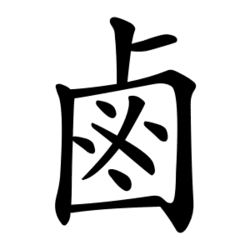Radical 197
| 鹵 | ||
|---|---|---|
| ||
| 鹵 (U+9E75) "salt" | ||
| Pronunciations | ||
| Pinyin: | lǔ | |
| Bopomofo: | ㄌㄨˇ | |
| Wade–Giles: | lu3 | |
| Cantonese Yale: | lou5 | |
| Jyutping: | lou5 | |
| Japanese Kana: | ロ ro (on'yomi) しお shio (kun'yomi) | |
| Sino-Korean: | 로 ro | |
| Hán-Việt: | lỗ | |
| Names | ||
| Japanese name(s): | ろ ro しお shio | |
| Hangul: | 소금밭 sogeumbat | |
| Stroke order animation | ||
 | ||
Radical 197 or radical salt (鹵部) meaning "salt" is one of the 6 Kangxi radicals (214 radicals in total) composed of 11 strokes.
In the Kangxi Dictionary, there are 44 characters (out of 49,030) to be found under this radical.
卤 (7 strokes), the simplified form of 鹵 is the 156th indexing component in the Table of Indexing Chinese Character Components predominantly adopted by Simplified Chinese dictionaries published in mainland China, while the traditional form 鹵 is listed as its associated indexing component.
Evolution
-
 Oracle bone script character
Oracle bone script character -
 Bronze script character
Bronze script character -
 Large seal script character
Large seal script character -
 Small seal script character
Small seal script character
Derived characters
| Strokes | Characters |
|---|---|
| +0 | 卤SC (=鹵) 鹵 |
| +4 | 鹶 |
| +5 | 鹷 |
| +8 | 鹸JP (=鹼) |
| +9 | 鹹 鹾SC (=鹺) |
| +10 | 鹺 鹻 (=鹼) |
| +13 | 鹼 鹽 |
Literature
- Fazzioli, Edoardo (1987). Chinese calligraphy : from pictograph to ideogram : the history of 214 essential Chinese/Japanese characters. calligraphy by Rebecca Hon Ko. New York: Abbeville Press. ISBN 0-89659-774-1.
- Lunde, Ken (Jan 5, 2009). "Appendix J: Japanese Character Sets" (PDF). CJKV Information Processing: Chinese, Japanese, Korean & Vietnamese Computing (Second ed.). Sebastopol, Calif.: O'Reilly Media. ISBN 978-0-596-51447-1.
External links
Wikimedia Commons has media related to Radical 197.